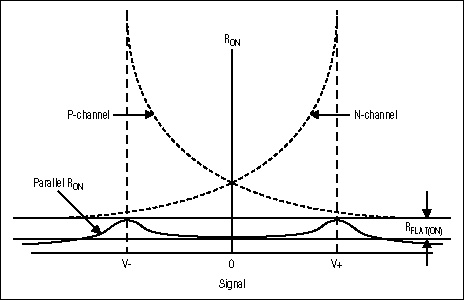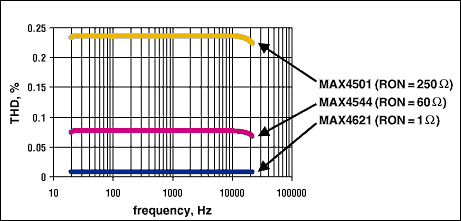Abstract: Analog switches are commonly used in audio systems to switch low-level inputs or adjust audio filter characterisTIcs. SelecTIng the proper analog switch can help opTImize the total harmonic distorTIon (THD) of a system within the designer's cost budget.
Analog switches are commonly used in audio systems to switch low-level inputs or adjust audio filter characteristics. Selecting the proper analog switch can help optimize the total harmonic distortion (THD) of a system within the designer's cost budget.
THD specification plays a critical role in determining the quality or fidelity of audio signals passing through or generated by audio systems. Thus, when designing audio systems, importance must be placed on selecting the proper components and board layout to minimize THD.
When passing a signal through a switch, the switch must not degrade signal integrity or introduce any new information onto the desired output signal. Any change in waveform is considered to be distortion and is obviously undesirable and also impossible to avoid, and thus must be minimized .

Figure 1.

THD is defined as the square root of the ratio of the sum of all of the squared second, third, and higher harmonics to the magnitude of the fundamental harmonic.
Selecting an analog switch with a minimum THD requires one with low on-resistance (RON) and consequently low on-resistance flatness (RFLAT (ON)). Some analog-switch data sheets neglect to specify flatness, but it can be assumed to be Approximately 10% of the on-resistance. Flatness is defined as the difference between the maximum and minimum values ​​of on-resistance as measured over the specified analog-signal range.

Figure 2. RFLAT (ON).
The on-resistance curves are determined by the length L, width W, electron and hole mobility (µn and µp, respectively), oxide capacitance COX, threshold voltage VT, and signal voltage VGS (VIN) of both MOSFETs.


As illustrated above, the on-resistance for the PMOS and the NMOS are in parallel, resulting in resistance R, which is a nonlinear function. The source of distortion arises from parallel PMOS and NMOS in series with constant load, causing a nonlinear attenuation of the signal passing through the switch. With multiple switches, THDs will add together. The following schematic shows this resistor-divider relationship of the switch and the load.

Figure 3.
In practical terms, maximum THD is determined by the following equation:
As observed in Figure 2, parallel RON, and therefore RFLAT (ON), can vary depending on the analog input signal, and maximum THD will occur at the greatest difference between the maximum and minimum values ​​of the parallel RON. Therefore, an analog input signal operating about a point below the maximum value will experience a lower THD.
Three different switches are shown below along with their on-resistance and corresponding measured THD. A standard test load of 10 kilohms was used to obtain the plot.

Figure 4. THD vs. frequency.
In audio systems, impedance loads of 1200, 600, 36, 32, 16, 8, 4, and 3 kilohms will be encountered, and, especially with very low impedances, on-resistance flatness (RFLAT (ON)) must be taken into consideration to minimize THD. Equation 4 will provide a starting point in selecting an analog switch if THD is the highest priority.

|
THD specification plays a critical role in determining the quality or fidelity of audio signals passing through or generated by audio systems. Thus, when designing audio systems, importance must be placed on selecting the proper components and board layout to minimize THD.
When passing a signal through a switch, the switch must not degrade signal integrity or introduce any new information onto the desired output signal. Any change in waveform is considered to be distortion and is obviously undesirable and also impossible to avoid, and thus must be minimized .

Figure 1.

THD is defined as the square root of the ratio of the sum of all of the squared second, third, and higher harmonics to the magnitude of the fundamental harmonic.
Selecting an analog switch with a minimum THD requires one with low on-resistance (RON) and consequently low on-resistance flatness (RFLAT (ON)). Some analog-switch data sheets neglect to specify flatness, but it can be assumed to be Approximately 10% of the on-resistance. Flatness is defined as the difference between the maximum and minimum values ​​of on-resistance as measured over the specified analog-signal range.

Figure 2. RFLAT (ON).
The on-resistance curves are determined by the length L, width W, electron and hole mobility (µn and µp, respectively), oxide capacitance COX, threshold voltage VT, and signal voltage VGS (VIN) of both MOSFETs.


As illustrated above, the on-resistance for the PMOS and the NMOS are in parallel, resulting in resistance R, which is a nonlinear function. The source of distortion arises from parallel PMOS and NMOS in series with constant load, causing a nonlinear attenuation of the signal passing through the switch. With multiple switches, THDs will add together. The following schematic shows this resistor-divider relationship of the switch and the load.

Figure 3.
In practical terms, maximum THD is determined by the following equation:

As observed in Figure 2, parallel RON, and therefore RFLAT (ON), can vary depending on the analog input signal, and maximum THD will occur at the greatest difference between the maximum and minimum values ​​of the parallel RON. Therefore, an analog input signal operating about a point below the maximum value will experience a lower THD.
Three different switches are shown below along with their on-resistance and corresponding measured THD. A standard test load of 10 kilohms was used to obtain the plot.

Figure 4. THD vs. frequency.
In audio systems, impedance loads of 1200, 600, 36, 32, 16, 8, 4, and 3 kilohms will be encountered, and, especially with very low impedances, on-resistance flatness (RFLAT (ON)) must be taken into consideration to minimize THD. Equation 4 will provide a starting point in selecting an analog switch if THD is the highest priority.
Reel with double-skin flanges, in pressed steel with a turned drum. The external flange curl is suited for lifting through automatic hooks. The available sizes are as per DIN 46395 / 46397 specifications or as indicated by the Customer, for a normal use up to 1250 mm of flange diameter. This reel is dynamically balanced for speeds up to 60 m/s.
Indicated for metallic wires and cables.
To be used on a wiredrawing, stranding or rope-making machine. It withstands annealing treatment
| Serial Number | Specification Model | Lateral Plate Diameter D1 | Major Diameter D2 | Axle Hole Diameter D4 | Carrying Hole Diameter D5 | Center Distance E of Axle Hole and Carrying Hole | External Width L1 | Internal Width L2 |
| 1 | 400 | 400 |
224/250 280 |
125/127 | 28 | 100 |
265 300 |
224 250 |
| 2 | 500 | 500 |
280/315 355 |
125/127 | 28 | 100 |
300 375 |
250 315 |
| 3 | 560 | 560 |
315/355 400 |
125/127 | 28 | 100 |
355 425 |
280 355 |
| 4 | 630 | 630 |
355/400 450 |
125/127 | 28 | 100 |
375 475 |
315 400 |
| 5 | 710 | 710 |
400/450 500 |
250 | 40 | 170 |
425 530 |
355 450 |
| 6 | 800 | 800 |
450/500 560 |
250 | 40 | 170 |
475 600 |
400 500 |
| 7 | 1000 | 1000 |
560/630 710 |
250 | 50 | 250 | 750 | 630 |
| 8 | 1250 | 1250 |
710/800 900 |
250 | 50 | 250 | 950 | 800 |

Double Layer Wire Spools, Cable Spool, Steel Cable Reel,Steel Wire Drum
NINGBO BEILUN TIAOYUE MACHINE CO., LTD. , https://www.spool-manufacturer.com
